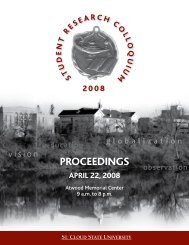Fall 2010 - St. Cloud State University
Fall 2010 - St. Cloud State University
Fall 2010 - St. Cloud State University
Create successful ePaper yourself
Turn your PDF publications into a flip-book with our unique Google optimized e-Paper software.
G r a d u a t e P r o g r a m<br />
International <strong>St</strong>udents<br />
Global Perspecives on Media<br />
By Scott Ed Holte<br />
<strong>St</strong>. <strong>Cloud</strong> <strong>St</strong>ate’s graduate program in mass communications includes<br />
students from Bangladesh, China, India, Indonesia, Kenya, Nigeria,<br />
and Vietnam. These students bring a rich diversity of experience and<br />
knowledge to their classes to share with one another and with American<br />
students in seminars like diversity issues in mass media and international<br />
mass communications.<br />
Aneil Kotval, who grew up in Bombay, India, came to the United <strong>St</strong>ates<br />
in 2001. Last fall Kotval researched the images of India in the United<br />
<strong>St</strong>ates edition of Time Magazine. “The photographers were shooting those<br />
images in a way so as to reinforce the stereotypes of what India is and what<br />
people think of India,” Kotval said. “A lot of the shots were of poverty; a<br />
lot of them were about people’s struggle or corruption.” Time Magazine<br />
did not make any effort to portray the economic development that has<br />
occurred in India within the last decade, Kotval explained. “When you have<br />
lived in the U.S. for so long, but you know what the truth is in your home<br />
country, you do after a point start seeing certain patterns in the way your<br />
country is depicted.” The international students in the graduate program are<br />
all too familiar with the disparity between reality and the images present<br />
in U.S. media.<br />
Wara Karim’s research in diversity issues in mass media focused on the<br />
way that Islam is presented in the media. Her empirical research showed<br />
that American media were much more likely than media in other countries<br />
to associate Islam with terrorism. In reality, Karim says, the Qur’an teaches<br />
non-violence. Karim believes that these portrayals of Islam are due to<br />
American stereotypes of Muslims, as well as a misunderstanding of the<br />
Islamic concept of Jihad.<br />
Yohana Nevilya, a student from Indonesia, took diversity issues in mass<br />
media, and her research focused on press coverage of AIDS in Indonesia.<br />
“They don’t talk about it,” Nevilya said. “They don’t talk about condoms<br />
or preventing AIDS.” In the few instances when the Indonesian press did<br />
mention AIDS, they did not indicate that transmission can occur through<br />
sexual activity.<br />
Jacob Dankasa, of Nigeria, researched press freedom in Africa when he<br />
took seminar in international mass communications. “In some places<br />
in Africa you have good press freedom,” said Dankasa. However, this<br />
freedom is limited in other parts of Africa. Dankasa found that in some<br />
countries the freedom that was taken away during colonization was never<br />
returned.<br />
Cam Le, a student from Vietnam, reflected on the International Mass<br />
Communications seminar. “It was very useful not only to know what other<br />
classmates think about communicational issues in my region but also learn<br />
about issues all around the world,” she said.<br />
Two students from China are in the graduate program: Shuai Zhang<br />
and Chen Wang. Both Zhang and Wang expressed an appreciation for<br />
Wara Karim<br />
Country of Origin:<br />
Bangladesh<br />
Research Interests:<br />
Depiction of Islam and<br />
association of Islam with<br />
terrorism in the mainstream<br />
media.<br />
<strong>St</strong>udent Spotlight<br />
Academic Conference:<br />
My paper, “Association of<br />
Islam with Terrorism: A<br />
Content Analysis of the 2008 Mumbai Terror Attacks in<br />
the United <strong>St</strong>ates, Hong Kong and Japanese Newspapers,”<br />
was accepted for presentation at the ACA/PCA Annual<br />
Conference <strong>2010</strong>.<br />
Thesis Topic: News Sources in the Coverage of the 2008<br />
Mumbai Terror Attacks: A Comparative study of Indian,<br />
Chinese and American Newspapers.<br />
Graduation Date: May 8, <strong>2010</strong><br />
Future Plans: I would like to gain some professional<br />
experience in the field of mass communications after<br />
graduation. I believe that professional experience is always<br />
very useful. But in the long run, I aspire to pursue a Ph.D. in<br />
Mass Communications. I would also like to contribute to the<br />
improvement of journalistic practices in my home country.<br />
the opportunities available in the seminar on international mass<br />
communications to both share about Chinese media and learn about<br />
media in other countries. Zhang said the seminar in international<br />
mass communications opened her eyes to the diversity of the<br />
world. She believes the seminar format of American education is<br />
one of its greatest strengths.<br />
Naomi Maina, of Kenya, has similar feelings about the seminars<br />
on international mass communications and diversity issues in mass<br />
media. “Personally I find myself having more to say,” said Maina.<br />
“I have something to bring to the table.” Maina researched the way<br />
in which the 2008 post-election violence in Kenya was portrayed<br />
in American media.<br />
All of the students who graduate from this program leave with a<br />
global perspective of the issues in mass media. This is one of the<br />
greatest strengths of the graduate program.<br />
C<br />
•M A S S omments 11<br />
• • • •

















